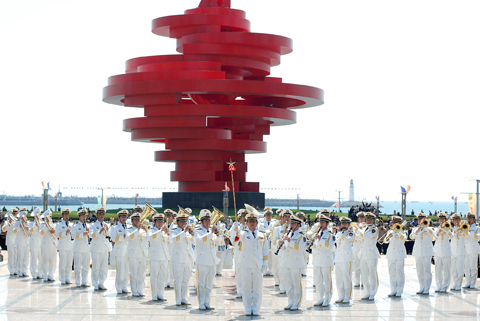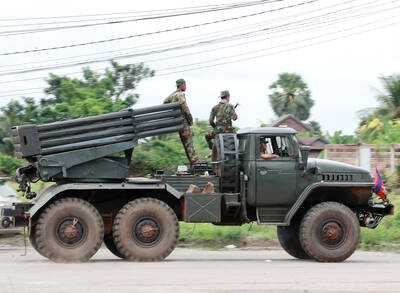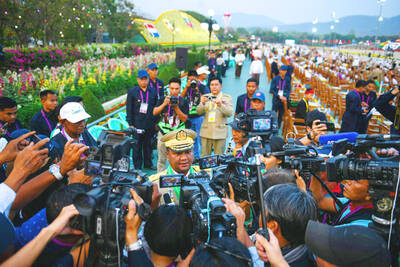The Chinese navy has added sophisticated nuclear submarines, destroyers and missile systems, but the holy grail of surface ships — an aircraft carrier — has stayed out on the horizon.
That may be about to change.
The navy will have one “very soon,” said the commander of the East China Fleet, Admiral Xu Hongmeng. The navy’s commander, Admiral Wu Shengli (吳勝利), spoke last week of plans for “large combat warships,” an apparent reference to carriers.

PHOTO: EPA
The comments come ahead of an unprecedented international fleet review tomorrow marking the 60th anniversary of the People’s Liberation Army (PLA) Navy and spotlighting its recent rapid development.
The navy is expected to take on even more ambitious goals in the next few years as it seeks to strengthen its ability to operate far from coastal bases and boost China’s international prestige.
“As China’s navy takes on missions that go beyond simple coastal defense, an aircraft carrier becomes an obvious addition to maritime power projection platforms,” said John Pike, a defense analyst and director of GlobalSecurity.org.
In his remarks to Xinhua news agency, Wu said the navy would speed up development of a technologically advanced, oceangoing fleet, stepping away from its traditional missions of coastal protection and blocking permanent independence for Taiwan.
No Chinese official has offered a specific timeframe for putting a carrier in the water or said how many might be built.
Operating a carrier would be a step toward a “sea-control capability” in Northeast Asia and the Indian Ocean, a strategy that could bring Beijing into conflict with the US, Japan, South Korea and India and raise doubts about Beijing’s self-declared defensive military posture, Pike said.
“It is not clear how such a long-range power projection and sea control strategy would fit in with China’s peaceful rise,” he said.
Having a carrier allows a navy to operate fixed-wing aircraft beyond the range of aircraft based on land. That would be key on missions to defend China’s territorial aspirations, especially in the South China Sea, where a half-dozen countries have overlapping claims.
US officials say they don’t think a Chinese carrier would pose much of a threat to their operations in the region, although that would depend on how China intended to use it.
In China to attend this week’s festivities, Admiral Gary Roughead, chief of US naval operations, said on Sunday there is “no doubt in my mind” that Beijing wants a carrier, but he said US forces would take such a development in stride.
“The advent of an aircraft carrier on the part of the PLA Navy, to me, really doesn’t change the nature of our operations at all,” Roughead said.
China insists it has both the financial muscle and shipbuilding ability to construct and operate a carrier and the development of sophisticated new home-built vessels seems to support that view.
Such expansion has been made possible by two decades of near-annual double-digit increases in military spending. China has announced a 14.9 percent rise in military spending in its budget for this year, to 480.6 billion yuan (US$70.3 billion).
The 225,000-sailor PLA Navy already operates more submarines than any other Asian country, with up to 10 nuclear-powered vessels and as many as 60 diesel-electric subs. It boasts almost 80 destroyers and frigates — more than a dozen of which have entered service since the 1990s — along with hundreds of smaller craft and support ships.
China’s second-generation, nuclear-powered Jin and Shang class submarines are considered just a notch below cutting-edge US and Russian craft.
The diesel-electric Yuan class boasts a Chinese-developed air-independent propulsion system that allows it to remain submerged for weeks, while Chinese Luyang destroyers and Jiangkai missile frigates incorporate stealth features and a mix of latest-generation Chinese and Russian weapon systems.
Still, operating an aircraft carrier requires orchestrating a highly complex matrix of sailors, aircraft, missile defenses, power plants, support ships, fuel and weather. In that, the Chinese navy has little experience.
“Carrier operations are very complex, difficult, and dangerous,” said retired Rear Admiral Eric McVadon, a former US Navy pilot who is now director of Asia-Pacific Studies at the Institute for Foreign Policy Analysis. “China’s current navy is not designed for carrier warfare.”
McVadon said China would build up to three modest carriers considerably smaller than the US Navy’s 100,000-tonne displacement Nimitz class carriers.
Unconfirmed reports have emerged on the Internet pointing to the construction of a dedicated carrier-building dock outside Shanghai.

In the sweltering streets of Jakarta, buskers carry towering, hollow puppets and pass around a bucket for donations. Now, they fear becoming outlaws. City authorities said they would crack down on use of the sacred ondel-ondel puppets, which can stand as tall as a truck, and they are drafting legislation to remove what they view as a street nuisance. Performances featuring the puppets — originally used by Jakarta’s Betawi people to ward off evil spirits — would be allowed only at set events. The ban could leave many ondel-ondel buskers in Jakarta jobless. “I am confused and anxious. I fear getting raided or even

POLITICAL PATRIARCHS: Recent clashes between Thailand and Cambodia are driven by an escalating feud between rival political families, analysts say The dispute over Thailand and Cambodia’s contested border, which dates back more than a century to disagreements over colonial-era maps, has broken into conflict before. However, the most recent clashes, which erupted on Thursday, have been fueled by another factor: a bitter feud between two powerful political patriarchs. Cambodian Senate President and former prime minister Hun Sen, 72, and former Thai prime minister Thaksin Shinawatra, 76, were once such close friends that they reportedly called one another brothers. Hun Sen has, over the years, supported Thaksin’s family during their long-running power struggle with Thailand’s military. Thaksin and his sister Yingluck stayed

Kemal Ozdemir looked up at the bare peaks of Mount Cilo in Turkey’s Kurdish majority southeast. “There were glaciers 10 years ago,” he recalled under a cloudless sky. A mountain guide for 15 years, Ozdemir then turned toward the torrent carrying dozens of blocks of ice below a slope covered with grass and rocks — a sign of glacier loss being exacerbated by global warming. “You can see that there are quite a few pieces of glacier in the water right now ... the reason why the waterfalls flow lushly actually shows us how fast the ice is melting,” he said.

RESTRUCTURE: Myanmar’s military has ended emergency rule and announced plans for elections in December, but critics said the move aims to entrench junta control Myanmar’s military government announced on Thursday that it was ending the state of emergency declared after it seized power in 2021 and would restructure administrative bodies to prepare for the new election at the end of the year. However, the polls planned for an unspecified date in December face serious obstacles, including a civil war raging over most of the country and pledges by opponents of the military rule to derail the election because they believe it can be neither free nor fair. Under the restructuring, Myanmar’s junta chief Min Aung Hlaing is giving up two posts, but would stay at the